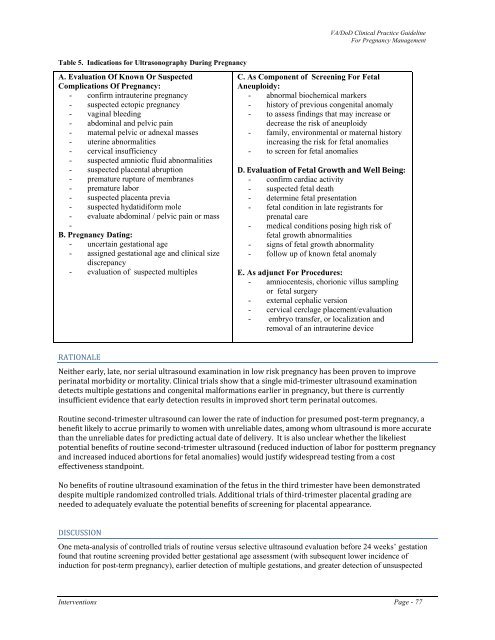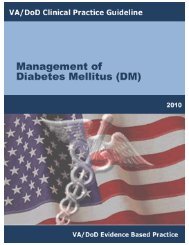Management of pregnancy - VA/DoD Clinical Practice Guidelines ...
Management of pregnancy - VA/DoD Clinical Practice Guidelines ...
Management of pregnancy - VA/DoD Clinical Practice Guidelines ...
You also want an ePaper? Increase the reach of your titles
YUMPU automatically turns print PDFs into web optimized ePapers that Google loves.
<strong>VA</strong>/<strong>DoD</strong> <strong>Clinical</strong> <strong>Practice</strong> Guideline<br />
For Pregnancy <strong>Management</strong><br />
Table 5. Indications for Ultrasonography During Pregnancy<br />
A. Evaluation Of Known Or Suspected<br />
Complications Of Pregnancy:<br />
- confirm intrauterine <strong>pregnancy</strong><br />
- suspected ectopic <strong>pregnancy</strong><br />
- vaginal bleeding<br />
- abdominal and pelvic pain<br />
- maternal pelvic or adnexal masses<br />
- uterine abnormalities<br />
- cervical insufficiency<br />
- suspected amniotic fluid abnormalities<br />
- suspected placental abruption<br />
- premature rupture <strong>of</strong> membranes<br />
- premature labor<br />
- suspected placenta previa<br />
- suspected hydatidiform mole<br />
- evaluate abdominal / pelvic pain or mass<br />
-<br />
B. Pregnancy Dating:<br />
- uncertain gestational age<br />
- assigned gestational age and clinical size<br />
discrepancy<br />
- evaluation <strong>of</strong> suspected multiples<br />
C. As Component <strong>of</strong> Screening For Fetal<br />
Aneuploidy:<br />
- abnormal biochemical markers<br />
- history <strong>of</strong> previous congenital anomaly<br />
- to assess findings that may increase or<br />
decrease the risk <strong>of</strong> aneuploidy<br />
- family, environmental or maternal history<br />
increasing the risk for fetal anomalies<br />
- to screen for fetal anomalies<br />
D. Evaluation <strong>of</strong> Fetal Growth and Well Being:<br />
- confirm cardiac activity<br />
- suspected fetal death<br />
- determine fetal presentation<br />
- fetal condition in late registrants for<br />
prenatal care<br />
- medical conditions posing high risk <strong>of</strong><br />
fetal growth abnormalities<br />
- signs <strong>of</strong> fetal growth abnormality<br />
- follow up <strong>of</strong> known fetal anomaly<br />
E. As adjunct For Procedures:<br />
- amniocentesis, chorionic villus sampling<br />
or fetal surgery<br />
- external cephalic version<br />
- cervical cerclage placement/evaluation<br />
- embryo transfer, or localization and<br />
removal <strong>of</strong> an intrauterine device<br />
RATIONALE<br />
Neither early, late, nor serial ultrasound examination in low risk <strong>pregnancy</strong> has been proven to improve<br />
perinatal morbidity or mortality. <strong>Clinical</strong> trials show that a single mid‐trimester ultrasound examination<br />
detects multiple gestations and congenital malformations earlier in <strong>pregnancy</strong>, but there is currently<br />
insufficient evidence that early detection results in improved short term perinatal outcomes.<br />
Routine second‐trimester ultrasound can lower the rate <strong>of</strong> induction for presumed post‐term <strong>pregnancy</strong>, a<br />
benefit likely to accrue primarily to women with unreliable dates, among whom ultrasound is more accurate<br />
than the unreliable dates for predicting actual date <strong>of</strong> delivery. It is also unclear whether the likeliest<br />
potential benefits <strong>of</strong> routine second‐trimester ultrasound (reduced induction <strong>of</strong> labor for postterm <strong>pregnancy</strong><br />
and increased induced abortions for fetal anomalies) would justify widespread testing from a cost<br />
effectiveness standpoint.<br />
No benefits <strong>of</strong> routine ultrasound examination <strong>of</strong> the fetus in the third trimester have been demonstrated<br />
despite multiple randomized controlled trials. Additional trials <strong>of</strong> third‐trimester placental grading are<br />
needed to adequately evaluate the potential benefits <strong>of</strong> screening for placental appearance.<br />
DISCUSSION<br />
One meta-analysis <strong>of</strong> controlled trials <strong>of</strong> routine versus selective ultrasound evaluation before 24 weeks’ gestation<br />
found that routine screening provided better gestational age assessment (with subsequent lower incidence <strong>of</strong><br />
induction for post-term <strong>pregnancy</strong>), earlier detection <strong>of</strong> multiple gestations, and greater detection <strong>of</strong> unsuspected<br />
Interventions Page - 77
















